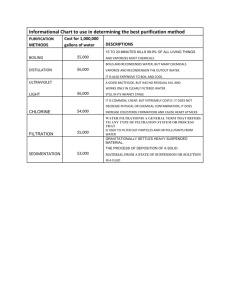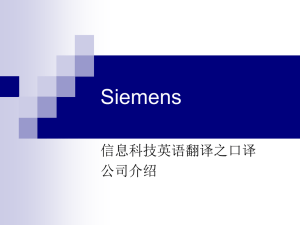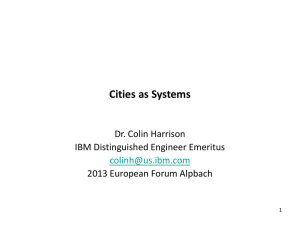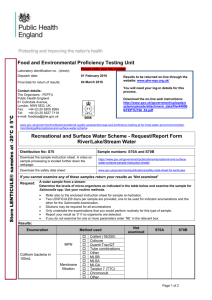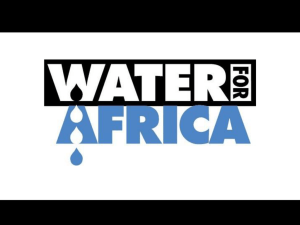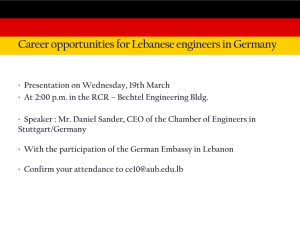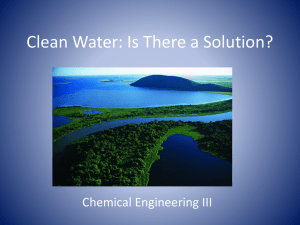Christopher Gordon Professor Elisa Warford WRIT 340 May 1, 2013
advertisement
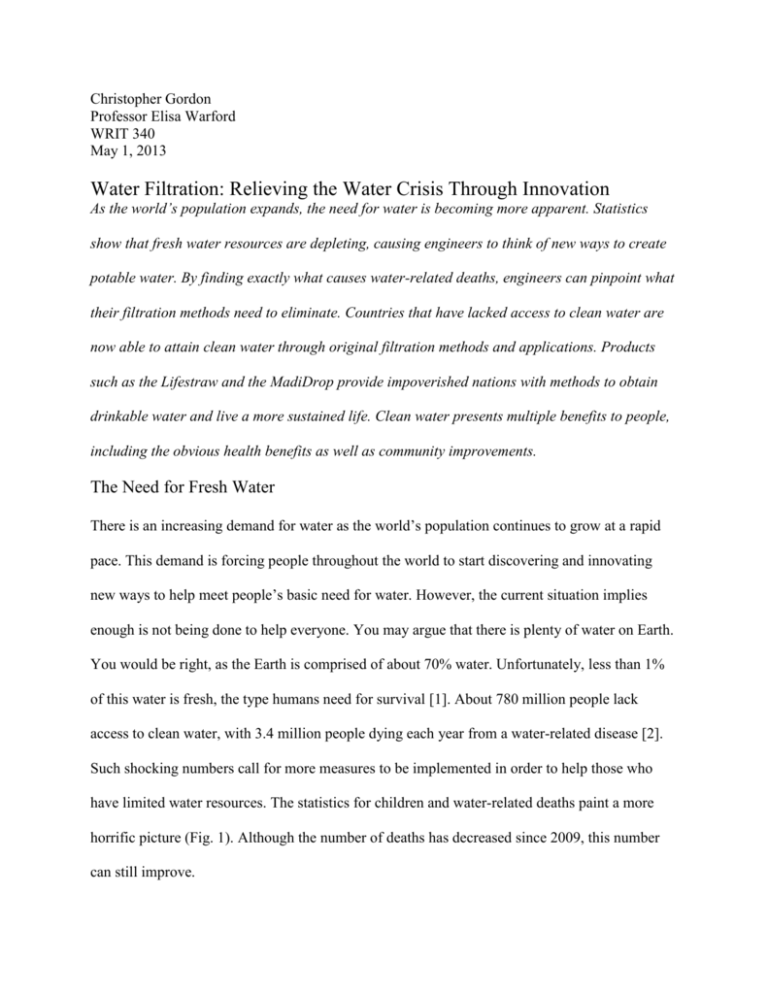
Christopher Gordon Professor Elisa Warford WRIT 340 May 1, 2013 Water Filtration: Relieving the Water Crisis Through Innovation As the world’s population expands, the need for water is becoming more apparent. Statistics show that fresh water resources are depleting, causing engineers to think of new ways to create potable water. By finding exactly what causes water-related deaths, engineers can pinpoint what their filtration methods need to eliminate. Countries that have lacked access to clean water are now able to attain clean water through original filtration methods and applications. Products such as the Lifestraw and the MadiDrop provide impoverished nations with methods to obtain drinkable water and live a more sustained life. Clean water presents multiple benefits to people, including the obvious health benefits as well as community improvements. The Need for Fresh Water There is an increasing demand for water as the world’s population continues to grow at a rapid pace. This demand is forcing people throughout the world to start discovering and innovating new ways to help meet people’s basic need for water. However, the current situation implies enough is not being done to help everyone. You may argue that there is plenty of water on Earth. You would be right, as the Earth is comprised of about 70% water. Unfortunately, less than 1% of this water is fresh, the type humans need for survival [1]. About 780 million people lack access to clean water, with 3.4 million people dying each year from a water-related disease [2]. Such shocking numbers call for more measures to be implemented in order to help those who have limited water resources. The statistics for children and water-related deaths paint a more horrific picture (Fig. 1). Although the number of deaths has decreased since 2009, this number can still improve. Figure 1: Recent statistics on water related deaths for children. Source: water.org The scarcity of water has caused an increase in conflicts regarding water. Out of the 181 reported conflicts over water from 3000 B.C. to the end of 2007, 59 of these conflicts have occurred in the 21st century [3]. This increase indicates that people are growing tense as they recognize the world’s water supply is slowly declining. Officials have also recognized the current need for new resources of water. Interior Minister of Taiwan Lee Hung-yuan voiced his concern to citizens. He warned the Taiwanese that their current supply of water will be inadequate by 2030, leading to problems with food and energy in the near future [4]. With such concern, many professionals are hurrying to solve this global crisis. Engineers are creating new water filtration methods and applications that will help alleviate these issues. These applications have been continually developing and are now reaching to the parts of the world that need it most. Impurities in Water Although these statistics are concerning, many of us in the United States find them difficult to relate to. We have many clean resources of water as compared to struggling areas in Asia and Africa. The water we typically receive is free from most impurities that are commonly found in water. These impurities are the direct cause of these deaths, as well as the reason why fresh water is becoming a valuable asset around the world. Pollutants such as sediment, arsenic, nitrates, biological pathogens (waterborne organisms), calcium, magnesium, mercury, zinc, and copper make water contaminated and unsuitable for human needs [5]. Many of these impurities have been linked to multiple forms of cancer, the main reason for water-related deaths. Engineers have pinpointed these sources of water-related deaths and have created innovative purification methods that greatly reduce the number of contaminants. By recognizing the cause of these deaths, they are able to design filtration methods and systems that directly eliminate these unwanted elements. Recent Filtration Methods and Applications: How They Work Filtration systems have been utilized for many years, but many methods have developed during the 21st century. With technological advances, engineers continue to invent products and methods that help the water crisis. The more recent methods include ultraviolet and desalination membrane filtration, which improve efficiency in reducing foreign objects in water compared to past filtration procedures. Applications such as the Lifestraw and the MadiDrop are now being used in parts of the world that desperately need new ways to create fresh water. Ultraviolet Filtration Ultraviolet filtration is a method that has been used recently in addressing the water crisis. Ultraviolet filtration deactivates almost all pathogens in the unclean water. The water is passed under an ultraviolet (UV) light source (Fig. 2), which eliminates the pathogens. Engineers have recently designed a UV system that kills bacteria effectively while also saving energy and expenses. The system utilizes microwaves which energize lamps to generate a particular UV wavelength of 245 nanometers (nm), which is optimal for removing pathogens [7]. UV light kills bacteria in the water by damaging its DNA. The nucleic bonds are broken and then incorrectly paired back together. This causes DNA to be misread, causing the bacteria to be unable to function normally or reproduce. However, this method is typically used along with other filters as it is unable to remove dirt or particles from the water. Advances in engineering have increased the lifetime of these lamps, causing systems to operate more consistently and providing fresh water with greater regularity. However, a drawback is its limited availability as it requires electricity to be used. This likely prevents its usage in less developed areas, as they typically lack access to electricity. Engineers could expand research on ultraviolet filtration to potentially provide it to impoverished areas without electricity. Figure 2: Close up view of multiple ultraviolet filters. Source: wateronline.com Desalination Membrane Filtration The latest advances in filtration methods have been explored by the Massachusetts Institute of Technology (MIT). Scientists there are attempting to create a membrane which can efficiently purify seawater, a process known as desalination. The membrane is on the nano scale, which is 10−9 meters. This is also referred to as a molecular scale. The membrane consists of graphene, which is a sheet of bonded carbon atoms that would be arranged in a hexagonal, honeycomb structure (Fig. 3). As water passes through this membrane, the larger salt molecules will not be able to flow through the molecular membrane. This results in only small water molecules passing through the pores, resulting in purified water. Scientists at MIT are still attempting to find the correct pore size to filter seawater adequately. With this issue, they are also hypothesizing ways to puncture the graphene to make the desired structure [8]. Research in this area is especially intriguing as most of the water on Earth is stored in our oceans. In comparison to other desalination methods, the graphene membrane requires much less energy for water purification. If completed successfully, the membrane would bring about technological advances that could potentially give fresh water access to populations living near the ocean. Figure 3: Water membrane filtering seawater. Membrane is shown as blue. Water molecules are red and white. Sodium and chlorine are displayed in green and purple. Source: earthsky.org Lifestraw Lifestraw is a recent invention that has directly impacted the lives of those who do not have easy access to potable water. Lifestraw is a simple, tubular device that can filter water without the use of electrical power (Fig. 4). The Lifestraw has filters inside of it that filter the water as it passes through the tube. This means the device can be placed directly in unclean water and will filter to become clean water before it enters the user’s mouth [9]. The Lifestraw only requires that air be blown through the tube periodically in order to keep the filters clean and unclogged. Such simple technology is changing the lives of people in Africa. Millions of Lifestraws have been sent to areas throughout Africa that need clean water. The company is helping the water crisis by going to many of the affected areas directly. Many users saw improvements in their lifestyle simply because they were given a portable water filter. The Lifestraw continues to provide people in Africa water filters, and engineers of the company continue to invent new products that these people can easily use. Figure 4: The Lifestraw. Source: gizmag.com MadiDrop The MadiDrop is a tablet created by a nonprofit organization from the University of Virginia. This clay tablet (Fig. 5)—comparable to the size of a coaster—contains nanoparticles of silver which filter and disinfect unclean water. Silver is able to filter water because its ions are able to reach the core of bacteria and bond to various sections of the cell, such as the DNA, proteins, and enzymes. The support systems of the cell become disabled, resulting in a stoppage of cellular growth and division. This ultimately leads to the bacteria dying, leaving only water molecules present. The MadiDrop is simply placed in the undrinkable water, and the tablet removes pathogens [10]. Although the tablet does not remove sediment, it is simple to use and cheap to transport. The creators of the MadiDrop have sent many of these devices to areas in South Africa. They also intend to teach the people there how to create more of these tablets, as the MadiDrop is effective for only a six month period. The organization also created a similar product which is called the PureMadi. Instead of only being a small tablet, it is a normal sized vase which can filter water much more efficiently. Technology in the MadiDrop and the PureMadi is as simple as the Lifestraw, and also helps to solve a very complex problem. Figure 5: Multiple MadiDrop tablets, compared to the size of a quarter. Source: news.virginia.edu Benefits of Clean Water Engineers must consider the purpose of providing clean water to those in need. With the statistics shown earlier, engineers can recognize the impact that clean water has on a person’s life. Fresh water prevents dehydration effectively, which is especially crucial in warmer climates. Access to drinkable water also provides energy to a person and allows the body to absorb nutrients more successfully. Potable water decreases the chances of getting ailments such as kidney stones. Clean water also prevents gastrointestinal issues such as constipation or diarrhea, the major source of water-related deaths. In addition to personal physical health, there is also a societal impact that clean water provides. By offering potable water to children, their education is improved because they no longer have to miss class due to water-related sickness. The improvement in enrollment correlates with improved knowledge and an awareness of the dangers of contaminated water. Areas also see an improvement in agriculture as the filtered water can now be used for growing multiple crops. Another result of clean water access is that areas which previously did not receive such water may observe a rise in income. This increase comes from more tourists visiting along with businesses potentially expanding their networks to these areas [6]. With clean water becoming more accessible, the surrounding property also becomes more valuable. Engineers acknowledge clean water’s multiple benefits as their motivation to design such water filtration systems. Water Filters: Creating the New Liquid Gold Water is essential to our lives. Everyone needs a source of fresh water. Without it, people across the world will continue to suffer from water-related diseases which usually lead to death. Engineers are hard at work designing new ways to reduce pollutants in water. Conscious of the benefits that clean water provides, engineers continue innovating filtration methods such as ultraviolet disinfection and new desalination techniques. They have also created applications, including the Lifestraw and the MadiDrop, which are being used in areas affected directly by lack of clean water. Engineers continue to strive for creating a better planet, and water purification is one solid step in completing this task. References [1] U.S. Department of the Interior. (2013, Jan. 10). How much water is there on, in, and above the Earth? [Online]. Available: http://ga.water.usgs.gov/edu/earthhowmuch.html [2] Water.org volunteers. (2013, Feb. 5). Water Facts [Online]. Available: http://water.org/water-crisis/water-facts/water/ [3] H. Bigas. (2012). The Global Water Crisis: Addressing an Urgent Security Issue [Online]. Available: http://www.inweh.unu.edu/WaterSecurity/documents/WaterSecurity_FINAL_Aug2012.pdf [4] S. Wu. (2013, Feb. 3). China Times: Take heed of looming water crisis [Online]. Available: http://focustaiwan.tw/ShowNews/WebNews_Detail.aspx?ID=201302030012&Type=aOPN [5] Excel Water Technologies Inc. (2012). Common Water Problems [Online]. Available: http://www.excelwater.com/eng/b2c/about_4.php [6] G. Hutton. (2012). World Health Organization: Global costs and benefits of drinking-water supply and sanitation interventions to reach the MDG target and universal coverage [Online]. Available: http://www.who.int/water_sanitation_health/publications/2012/globalcosts.pdf [7] Severn Trent Services. (2013, Jan. 28). UV Disinfection System Kills Bacteria in Municipal Wastewater [Online]. Available: http://news.thomasnet.com/fullstory/UV-Disinfection-Systemkills-bacteria-in-municipal-wastewater-20002035 [8] D. Conners. (2013, Jan. 21). New Water Desalination Technology Shows Promise [Online]. Available: http://earthsky.org/human-world/new-water-desalination-technology-shows-promise [9] Lifestraw representatives (2012). Lifestraw-Features [Online]. Available: http://www.vestergaard-frandsen.com/lifestraw/lifestraw/features [10] University of Virginia (2013, Feb. 9). An Innovative Nanotech Water Purification Tablet for Developing World (w/ video) [Online]. Available: http://www.nanowerk.com/news2/newsid=28935.php
